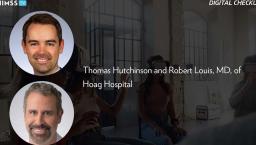A guide to pop health IT vendors and SDOH tools

As health systems work to meet the imperatives of quality improvement and value-based reimbursement, they’re deploying analytics tools to manage patient populations, gain insights into the needs of specific groups and direct care resources to those who need them most.
The technology available to help providers meet these complex demands – delivering treatment for chronic conditions and comorbidities in traditional care settings, while also coordinating outreach and partnerships to meet basic wellness needs such as food security and transportation – are fast-evolving.
Because of the wide-ranging and varying nature of pop health and SDOH needs, having a good understanding of how these many tools and platforms can work for specific organizational strategies is essential.
To help health system CIOs, IT professionals, clinicians, care managers and other provider leaders wade through the many technology offerings, Healthcare IT News is compiling this comprehensive special report detailing the vendors in this space. This list will be updated.
Arcadia
Arcadia uses social determinants of health as a key data source to support improved patient outcomes and health system financial health in value-based care. As COVID-19 places increased care delivery and economic strain on health systems, using SDOH can be critical to better identifying patients at risk of COVID-19 complications, better identifying patients in need of socioeconomic supports, and ensuring system resources are better matched to patients in need of care.
Arcadia’s COVID-19 Surveillance and Engagement Toolkit and COVID-19 Recovery Toolkit both incorporate SDOH factors, as does the entire Arcadia Analytics population health management platform. Arcadia Analytics is used by health plans, health systems, accountable care organizations and provider groups to reduce medical expenses, improve risk coding accuracy, and improve quality and patient health outcomes. The platform continuously aggregates and curates a complete and up-to-date data foundation, provides relevant, timely and predictive analytics, and enables action through care management tools and in-workflow insights at the point of care.
Arcadia sources patient-specific SDOH information directly from patients and their medical records in clinical EHRs, integrating with more than 50 behavioral and physical health EHRs out of the box. Arcadia also infers SDOH-related information from the patient’s medical record and from third-party data sources. Arcadia is uniquely positioned to do this work given that a typical customer implementation aggregates a massive amount of data from multiple health plans, all contributing EHRs in a network, and third-party sources.
This aggregated data informs Arcadia’s machine learning algorithms to support core patient-centered workflows with a set of predictive models: impact, engagement and opportunity. Arcadia’s multi-dimensional models rely heavily on SDOH information for improved precision – allowing the care team to have a set of “next best actions” specific to each patient.
Arcadia’s models include demographic, medical and socioeconomic factors in addition to cost of care. This approach helps guard against bias and surfaces a more diverse mix of patients who may not be receiving appropriate care and could benefit from interventions like care management. Arcadia tracks dozens of geographic variables about every member, including education levels, access to transportation, income, household characteristics and more. These neighborhood factors can be further enhanced with direct patient-supplied social determinants of health (via surveys, community data sources or the EHR).
As healthcare organizations become more familiar with the use of algorithm-driven recommendations, Arcadia allows them to begin automating the actions they take in response. Arcadia Analytics can automatically push patients down suggested care pathways and workflows to improve care team efficiency. Arcadia’s full suite of tools, and these SDOH-driven algorithms in particular, have been key to its MSSP ACO customers for shared savings bonuses.
CancerIQ
CancerIQ’s precision health platform enables providers to identify, evaluate and manage entire patient populations based on individual genetic risk factors. By analyzing family history, running predictive risk models and automating national guidelines, CancerIQ is designed to help empower providers to predict, preempt and prevent disease.
The platform supports both in-office and virtual care and has been adopted by more than 65 health systems across the country. CancerIQ fully integrates with genetics laboratories, specialty software vendors and EHRs, and was recently validated in the Cerner App Gallery.
Using an iPad or other handheld mobile device, patients answer simple multiple-choice questions. CancerIQ then analyzes family history and runs predictive risk models. Those flagged as high-risk are referred for genetic counseling and personalized care management. The technology assists in the development of a comprehensive care plan based on national clinical guidelines from the National Comprehensive Cancer Network.
CancerIQ expands access to genetic testing and helps organizations recognize cost savings by caring for patients with the goal of reducing risk, preventing cancer and improving outcomes (via services like MRIs and mammograms) as opposed to treating later-stage cancer, which is costly and has poorer outcomes.
Cerner
Cerner’s EHR-agnostic insights platform HealtheIntent helps health systems and other provider organizations create and operate high-performing networks across regions and populations, the company said. Cerner’s offering is designed to help organizations strengthen and develop profitable relationships; manage care across networks; deliver on outcomes, cost and experience; and expand reach to attract and retain people.
The HealtheIntent platform aggregates and normalizes data from multiple, disparate sources, including EHRs, payers and plan sponsors, labs, and a broad range of additional sources. Within the HealtheIntent platform, each person’s historical data is linked and normalized to create a longitudinal record. The longitudinal record serves as the basis for a broad range of analytic, care and provider performance-management applications and patient and provider engagement solutions.
Several applications are built on the HealtheIntent platform, including a set of business intelligence and reporting tools with HealtheAnalytics and HealtheEDW; the community care management tool HealtheCare; chronic condition and wellness cohort identification and clinical quality and gaps in care insights with HealtheRegistries; hierarchical condition category and risk-identification and stratification capabilities with Cerner Hierarchical Condition Categories; and a data science ecosystem that enables organizations to build, test and validate predictive models with HealtheDataLab.
HealtheCRM, which is Cerner’s integration of HealtheIntent with Salesforce CRM technologies, assists organizations in their consumer engagement initiatives and delivery of personalized care recommendations based on insights related to gaps in care, as well as provider-engagement strategies. Cerner also offers consumer-engagement solutions designed to enable customized consumer experiences and an agnostic approach to integration.
A key application is HealtheLife, a set of web and mobile-based consumer-engagement tools designed to provide users with near-real-time access to current information and resources and to help them effectively engage in their health and care.
Another area of rapid development is HealtheIntent’s capabilities to capture social determinants of health data and to use such data to help support providers in their efforts to target and implement patient outreach and care coordination strategies that affect those most in need. The solutions enable organizations to collect SDOH data and analyze individuals and populations both at the point of care and over time, and provide actionable recommendations for care improvement based on nonclinical factors such as food, transportation and housing insecurity.
The tools also help organizations with opportunities to integrate local social support services and resources into care plans in order to improve and maintain the health status of the populations they are responsible for managing.
Cerner also offers a rapidly expanding scope of advisory services in the areas of analytics, care management, primary care, network design, provider incentives, risk adjustment and others. Cerner advisory services are structured to provide evidence-based approaches that help organizations plan, design and implement effective provider network performance, care, patient-engagement and financial-management strategies.
Color
Color is a health technology company that has built a data-driven platform for population health. Color provides the technology and infrastructure for large-scale public health initiatives, from population genomics programs to high-throughput COVID-19 testing.
While Color began as a population genomics company, it has developed a high-throughput COVID-19 testing platform since the start of the pandemic, including a CLIA-certified COVID-19 testing laboratory that integrates with public health tools. Color’s COVID-19 testing platform includes an integrated software platform to manage risk screening, test ordering, results delivery, case management, contact tracing and public health agency case reporting. Color’s lab operates under FDA-approved protocols and only processes COVID-19 samples collected by qualified healthcare professionals.
In April 2020, Color launched CityTestSF in partnership with San Francisco Mayor London Breed. Since launching, CityTestSF has returned more than 20,000 test results to people in San Francisco. Color has also partnered with the Morehouse School of Medicine in Atlanta, Georgia, on a testing program that will enable the school to reopen its campus. Recently, the company received emergency use authorization from the FDA for a technology that could help scale COVID-19 testing to the level needed to reopen the economy safely.
Even during the pandemic, Color is continuing its genomics work with partners including health systems, research and pharma institutions, employers, and healthcare providers to provide population health insight at scale and, at the same time, accessible, clinically actionable results to every person who takes the Color genomics test.
All patients who take a Color test are provided their results through genetic counselors, who help them navigate decisions about their personal health. Color’s platform powers partners’ population genomics programs, whether as an end-to-end solution or as a means to support existing capabilities.
Enli Health Intelligence
Enli develops systems for value-based care analytics and coordination that process SDOH data and make it actionable through task and decision support workflows and dashboards. Cohorts are identified and continuously updated using SDOH data (or a blend of SDOH, clinical and claims data). Patients meeting the segmentation criteria are automatically placed into care-coordination programs with patient-centric task and decision support.
The SDOH data also manifests in a visual decision-support dashboard embedded in the EHR, or accessible through a web page. Actionable SDOH information can bolster clinical quality or practice efficiency programs, or it can be used to advance specific SDOH initiatives, like outreach programs for medication assistance or housing resources.
Enli captures SDOH data from the PRAPARE assessment or other commonly used data sources. Information can also be entered on the fly, and all structured data is copied to the patient’s medical record. Enli processes the SDOH data so that it can be intelligently presented at the moment outreach is being conducted or decisions are being made – within Enli’s care coordination programs, or in decision-support dashboards accessible in the exam room.
Enli makes SDOH data actionable for care coordinators by incorporating it into Enli Central Worklist care coordination programs. The data is presented within the specified task and decision support workflow, and can inform care team interactions with the patient. If a patient doesn’t have reliable transportation, for example, that knowledge can be used to design a more effective plan of care that is tailored for the individual. The data can also be used to drive programs specific to SDOH, like awareness for housing resources and food assistance programs.
Enli makes SDOH data actionable for providers in the clinic and exam room by presenting it in a visual dashboard embedded in the EHR, or accessible from a web page. Color queues inform the team of potential SDOH risk factors at a glance. If a patient has trouble affording medication, that information can be accessed by the care team at the point of care, and arrangements can be proactively made for medication assistance. This avoids embarrassment for the patient and helps support better outcomes.
Geneia
Geneia is a healthcare analytics and services company. It supports nearly 8 million patients through its analytics, has more than 60 million benchmark lives, and provides management of clinical services to a population of more than 750,000, the company said.
The company has a suite of products designed to help healthcare providers, hospitals and health plans better identify and actively manage high-risk populations, improve quality measurement and outcomes, and strengthen revenue.
The Theon platform is Geneia’s analytics, insights and care management system. It integrates claims, clinical and related individual and population data, including social determinants of health, and delivers timely and prioritized insights into performance, risk cost and utilization, the company said. The platform has predictive analytics to guide early, targeted and personalized interventions to better manage chronic disease and improve outcomes and quality, the company added.
The Theon platform’s key functionality supports: proactive individual and population health management; clinical risk profiling, stratification and analysis; cost and quality analytics; provider performance analysis; and quality measure and risk-adjustment prioritization and optimization.
Health Catalyst
Health Catalyst offers data and analytics technologies and services designed to gather and generate actionable insights from data and help improve outcomes. The company offers an analytics platform, a data warehouse and a variety of analytics applications, along with services to install technologies and enable the transformation.
Powered by a metadata-driven ETL engine, the Health Catalyst Analytics Platform extracts data from a healthcare organization’s many source systems and gathers them into the company’s Late-Binding Data Warehouse, designed to provide timely, quality, cross-organizational data. Through interactive visualizations, decision-makers can bring that data into focus and deliver specific, actionable interventions in quality, outcomes, patient safety and waste reduction, the company said.
Health Catalyst offers a range of applications to accelerate insights that enable focused efforts on care improvement. Care-management and patient-relationship applications follow patients across the transitions in care settings, eliminating gaps and helping to prevent readmissions and potential CMS penalties. Clinical-analytics and decision-support applications enable clinical-improvement teams to go beyond basic indicators like readmissions and length of stay to focus on specific clinical measures needed to manage baseline population health processes and outcomes.
Financial decision support applications combine finance data sources with billing, claims, clinical, costing and patient satisfaction data to assist in understanding the causes and effects of historical changes in revenue with prospective changes in the provision of care. Operations and performance-management applications enable focused efforts toward specific operational and workflow efficiency, standardization and waste reduction goals.
Research informatics are advanced analytics to identify and extract the most useful data, prioritize areas for improvement, and apply effort where it will create the most value. Care areas for which Health Catalyst has developed advanced applications include emergency services, surgical services, and outpatient and ambulatory clinics.
Health Catalyst products and services are optimized for the healthcare environment, targeted to specific clinical and operational outcomes, flexible with regard to an organization’s level of sophistication in analytics, and scalable to meet future needs, the company contended.
Service areas include: accountable care and financial; benchmarking and comparative analytics; care management and patient relationships; clinical analytics; and operations and performance management.
Patient safety products and services specific to the COVID-19 crisis include: capacity planning; clinical trials tracking; financial-impact recovery; activity-based costing; national data sets and registry; rapid-response analytics; patient and staff tracking; patient safety monitoring; staff augmentation; and automated detection and analysis.
HealthEC
HealthEC offers a configurable population health, data analytics and artificial intelligence platform to support specific care management goals for healthcare organizations. The company’s data source-agnostic technology aggregates and analyzes hundreds of diverse information feeds in near-real time — including claims, EHR, HIE and lab data — to build longitudinal care records customized for each organization. HealthEC’s clients include healthcare providers organized as clinically integrated networks or ACOs for Medicaid programs and public health initiatives. The intelligent platform uses machine learning to automatically assemble personalized care plans for every patient. Care managers use these plans to coordinate and manage care.
SDOH data is captured and integrated into HealthEC’s population health platform through its CareConnect module and embedded SDOH assessment tool. The web-based application aggregates individual components of the assessment completed by multiple providers, agencies or the patients themselves. This capability gives the care team actionable insights into barriers and problems while also recommending interventions. The interventions may be assigned to the most appropriate service provider including a soup kitchen, meals on wheels, SNAP or a CHIP program administering agency. Users can follow up and track interventions all the way to closure.
With CareConnect, care managers can customize system functionality and dashboards to more effectively close care gaps and assign social services to address SDOH needs. Community resources can also document their work within HealthEC and their information flows back into the population health platform to create a comprehensive “community” patient record.
For example, during the COVID-19 pandemic, HealthEC aggregated medical claims data with clinical data to compile high-risk target lists for case management outreach, monitoring and tracking of suggested interventions focused on SDOH issues. Social issues that impact care and recovery may include housing, nutrition, social isolation for the elderly, substance or alcohol abuse, or even extracting signs of abuse and violence in the home.
Healthify
Most healthcare organizations recognize the importance of addressing social determinants as a powerful factor in a person’s health, yet there is difficulty connecting patients to the community services they need, Healthify said. When they do, the healthcare organizations don’t always know whether the connection has been made and what the impact on the intervention was, due to the fragmentation between healthcare professionals and social service providers, the company added.
Through its IT, Healthify partners with health systems, health insurance plans and relevant public sector organizations to integrate social determinants of health into the healthcare ecosystem to enable virtual referrals within communities. The interoperable technology helps health plans and clinicians develop and maintain a coordinated network of community partners and introduce a flow of information to address the social determinants of health.
Each community network is able to concurrently address the needs of complex populations and track outcomes on one centralized technology platform. On the platform, users assess and identify social needs; find and connect patients to validated resources; coordinate bidirectional referrals; and track population health data to understand the impact of interventions on outcomes and costs. The software also tracks and manages follow-ups to ensure connections, and progress, are being made. The platform is built for enterprise organizations and supports integrations with electronic health records, health information exchanges and other care management systems to support specific workflows and data needs.
Innovaccer
Innovaccer offers the FHIR-enabled Data Activation Platform, which is custom-built to advance the goal of developing a patient-centered, connected care delivery continuum. Its smart platform creates unified patient records for healthcare providers and payers to enable transparent, real-time and collaborative care delivery. It leverages artificial intelligence and data analytics to automate routine workflows and reduce manual overhead to increase the efficiency of the care procedures and devise better care plans.
The platform includes an integration and analysis engine to clean and aggregate healthcare data from sources including electronic health records, claims, pharmacies, hospitals and labs. The platform is built on a Hadoop-based big data repository with a scalable architecture that allows integration of disparate data sources without having to write code. Its agile and modular structure can ingest structured, semi-structured and unstructured data, pool it as a single source of truth, and work on a central HL7 FHIR-based data schema.
After the data is ingested, the platform uses machine learning to check the quality of data to identify any anomalies in mapping or sources. The platform allows the users to run multiple analytics on their patient population on various measures. The platform can integrate data from over 60 types of data sources and receive and deliver data in 150 formats, ensuring its authenticity and integrity with quality checks on 62 coding standards. The platform provides connectors to over 200 health IT vendors.
Innovaccer’s solution for social determinants of health assists organizations in understanding the social factors affecting their patient population drilled-down to an individual patient level. The solution also allows patients to find community services and track social needs. Innovaccer’s proprietary Social Vulnerability Indices (SVI) approach analyzes more than 55 social and economic factors that affect the overall health of a region. The model can calculate the social vulnerability of any region drilled-down to the Zip code level. Providers can gauge near- or long-term impacts of these factors on their patient population.
Interpreta
Interpreta Clinical Action is a real-time prospective analytics SaaS for health plans and independent physician associations. Its analytics engine unifies interpretation of clinical, genomic, quality, risk adjustment and other needs and is updated daily. Millions of patient datasets are processed within minutes, ensuring data is always up to date and false-positive alerts are eliminated by mitigating analytical latency, the company said. The real-time prospective engine works to identify clinical problems before they are too late to address.
Interpreta Clinical Action is built with ease of use and clarity in mind, with prospective insights and reasoning. With a single-sign-on and an API-microservices architecture, the Interpreta system unifies health operations across disparate applications, platforms and workflows, and allows issues to be fixed within the clinical workflow.
Interpreta Clinical Action is presented as a set of modules that work independently and can be used in parallel to provide a comprehensive overview for patient care. Each module offers a different view of the patient while providing chase lists, suspecting, medical record review and diagnosis coding.
The system includes five modules: HCC Risk Adjustment module enables a quick assessment of opportunities to identify acute and chronic diagnoses in the population. Its HEDIS module provides continuous population updates on compliance and open gaps in NCQA HEDIS measures. Its STARS module delivers continuous population updates on compliance and open gaps in compliance with a selection of CMS STARS measures. Its Continuous Member Prioritization module provides automated insights for providers and healthcare organizations based on four essential questions about their population. Genomics module is a value-based pharmacogenomics platform for population health information.
Lightbeam Health Solutions
Lightbeam Health Solutions addresses social determinants of health in healthcare organizations’ patient populations with a two-pronged approach: creating comprehensive patient profiles with data gathered from disparate sources, and initiating targeted clinical transformation efforts based on what they need and their situation.
The technology is vendor-agnostic and built to support data feeds from disparate sources and centralize them within their population health management platform. These sources include post-adjudicated claims data from payers; and clinical data from ambulatory settings, acute electronic health records, reference labs and a variety of other sources. The compiled information can track a patient’s current state of health, take note when different appointments or hospital events occurred, and determine the right level of outreach needed to prevent new conditions occurring or pre-existing ones worsening.
These insights help users identify trends in their patient populations, such as why they miss appointments, whether or not they picked up their medication, and, ultimately, the reasons behind care gaps, which can be traced to social determinants of health.
Clinical transformation with Lightbeam is a summation of the research, planning and building of the detailed care management programs that improve patients’ health while decreasing an organization’s spending. The technology identifies ways to help implement care management workflows that address the immediate and long-term needs of a patient demographic. Clinical transformation plays a crucial role in client success, transforming insights into rapid outcomes through the development, implementation, coordination and monitoring of cohorts. They are a branch within Lightbeam’s Advisory Services department.
Lumeris
Lumeris is a value-based-care managed services company helping health systems and providers improve clinical and financial outcomes. It partners with health systems across all lines of business and populations, at any stage in their transition to value-based care, whether they are just starting or are already developing population health capabilities.
By aligning providers and payers with a proven model that coordinates operational processes, resources and technology, Lumeris works to help healthcare organizations achieve high-quality, cost-effective care with satisfied consumers and engaged physicians.
Through strategic advising, enabling technology and operational expertise, Lumeris brings systems to help health systems and providers navigate their transformation, tailored to their business and market conditions. The company’s team of advisors and operators leverage data and a deep understanding of markets and organizations to codesign an implementation plan that operationalizes a strategy for moving to risk.
Supported by a cloud-based population health platform built for value-based care, Lumeris uses advanced analytics, social determinants of health and EHR-agnostic technologies to enable care teams to better coordinate care and improve health at the individual patient and population levels. The company works to innovate around its clinical and technology operations, learning and sharing best practices to help provider organizations in delivering better care.
To support healthcare organizations during the COVID-19 pandemic, the Lumeris Virtual Care Access Package provides COVID-19-specific models, analytics and services so payers and providers can prepare for COVID-19 impacts. It is designed to help organizations more effectively identify, prioritize and manage patients at risk for COVID-19, resulting in more efficient use of limited resources.
Medecision
Medecision is a virtual care and digital health company. The company’s mission is to connect people, health plans, health systems and care teams to drive positive health outcomes in a seamless, interconnected way.
Aerial is a software-as-a-service health platform with a suite of engagement and workflow systems. Aerial provides risk-bearing organizations with tools to support care, case and utilization management; provider and consumer engagement; and analytics and performance management. It connects the care ecosystem and enables consumers to be surrounded with personalized healthcare experiences focused on efficient and effective support – whether those experiences are delivered virtually or in-person, the vendor said.
By providing a secure, scalable set of enterprise and health data across systems, including addressing social determinants of health, Aerial is designed to give a 360-degree view of the healthcare consumer, ensuring those consumers and their care and support teams are coordinated, communicating and connected, the vendor added.
Medecision’s professional services division, Aveus, provides consulting services to guide healthcare organizations’ strategy, innovation and customer experience.
During the COVID-19 pandemic, as the coordination and management of care for individuals with complex healthcare needs has rapidly shifted to virtual connections, Aerial has been enhanced to further support health plans, care delivery organizations and healthcare consumers. Aerial offers a COVID-19 care management program; a mechanical ventilator case-management program; behavioral health assessments; and Aerial InCircle, a social-mobile personal health record plus secure, permission-based texting and video chat to connect consumers to their care teams and caregivers.
NowPow
NowPow’s community referral and data analytics platform helps healthcare organizations connect people to community-based services so they can stay well, meet basic needs, manage illness and care for others. NowPow’s platform creates data-driven, highly matched referrals to support a full spectrum of needs including things like in-home personal or nursing care, food/nutrition, housing, mental health, or support with cancer, diabetes management or caregiving. The technology can be used to extend both in-person and virtual care.
The company has built and managed referral networks of varying sizes and sectors across 15 geographies to advance whole-person care and social determinants of health initiatives, and address healthcare disparities and inequities. The platform currently reflects the COVID-19 operating status for more than 65,000 community-based services, as validated by the company’s community resource team.
Using the platform, which integrates with electronic health records, patient portals and other care management systems using the FHIR standard, users can identify people’s needs. The technology then automatically maps those needs with optimal services using more than 50 evidence-based algorithms, and filters results by critical access factors like COVID-19 operating status (for example, delivery, phone, virtual or pick-up), location, languages spoken, documents needed and other eligibility requirements. These personalized referrals can be shared with people via text, e-mail or print in 100+ languages. The technology supports one-way referrals that contain no client data, as well as closed-loop referrals that support bi-directional patient and community engagement and document referral outcomes.
NowPow’s data allows organizations to understand outcomes at the individual, population and community level so they can assess initiatives and inform partnerships, policies and investments. During COVID-19, NowPow also released a series of interactive maps that show by ZIP code how resource availability is changing over time in the nation’s hardest hit areas.
Optum
Optum Performance Analytics brings together clinical and financial analytics. It works by integrating clinical and claims data with social determinants of health indices and behavioral and patient-reported data to present a view of patients, physicians, facilities and networks. Optum Performance Analytics helps predict clinical risk in the patient population using predictive models and methods. It also uncovers pockets of risk in patient populations and networks allowing for opportunities to take action to improve future outcomes.
The same patient-level information can be leveraged to improve metrics used in value-based programs and add an additional layer of depth to the assessment of provider performance and shared savings programs.
The Optum Symmetry suite of solutions helps users manage clinical resources to assess risk, measure quality and conduct predictive modeling. The Symmetry suite is an end-to-end solution that helps healthcare organizations measure value by allowing for apples-to-apples comparisons of members, populations, providers and networks. It facilitates a better understanding of variation, outliers and opportunities for improvement in clinical and financial performance. The Symmetry suite helps organizations address three key healthcare management issues: cost and utilization management; risk measurement and prediction; and quality measurement.
Symmetry focuses on six key categories: episode treatment groups, procedure episode groups, procedure episode groups, drug regimen complexity, quality measurement and procedure quality measures.
Orion Health
Orion Health develops software to support the delivery of optimized healthcare. From patient-generated data to social determinants of health to large genomic profiles, clinicians are overloaded with information and do not have the time to both read everything in a patient’s record and synthesize what matters. It can be difficult for clinicians to know what information is the most relevant and what they need to focus on.
With more than 25 years’ experience, Orion Health offers flexible technology that enables organizations to target the right patients and deliver the right kind of care at the right place, supporting the management of individualized patient care, the technology vendor said.
Its HIE platform, Amadeus, delivers a comprehensive approach to acquiring, enriching, analyzing and presenting actionable clinical and claims data, as well as nontraditional data. The scalable and open platform supports population health management initiatives and value-based care models, and provides healthcare professionals with real-time cognitive support at the point of care.
The company’s analytics technology enables organizations to explore data, stratify a patient population, and identify at-risk patients to allow for further action. And its clinical workflow tools then allow for patients to be matched with appropriate interventions, from screening and referrals through to medication management and care pathways.
The company also offers a direct secure messaging platform that provides reliable and protected communication between patients, healthcare providers and organizations across desktop and electronic health record systems. Users can quickly send accurate patient information to other healthcare providers or even to the patients themselves.
Philips
Philips’ population health management portfolio helps healthcare organizations extend care outside of clinical environments and proactively engage patients in the communities where they live by enhancing collaboration and visibility into the most vulnerable populations. Technology leverages advanced analytics tools to aggregate patient data, and identify and stratify populations according to acuity and risk.
Care teams can use this data to develop care plans, and effectively coordinate and navigate care across providers and networks. By leveraging data for informed decision support, care teams can also appropriately deploy connected devices and remote-monitoring programs to virtually connect with and engage patients. Organizations can then evaluate and analyze retrospective and prospective insights.
A critical piece of Philips’ population health management offering is its data aggregation capabilities. This allows organizations to normalize and combine data from disparate systems, and build longitudinal patient records to extract meaningful, actionable insights into effective ways to manage patient care. By unifying patient data across various sources – such as primary care, specialists, labs, pharmacies and social determinants of health – and organizing it for simplified interpretation, organizations can make better-informed care decisions to help drive and track improved clinical outcomes.
This visibility allows for care teams to plan and deploy care where patients live, and support them in better managing their chronic and complex conditions. As part of Philips’ population health management portfolio, providers are offered tools and connected devices to help track patients remotely, enabling timely clinical decisions; collaborate with the patient’s care team and social support system; and detect negative trends before health problems escalate to help facilitate earlier intervention.
Signify Health
Signify Health is a vendor of healthcare systems designed to keep people healthy and happy at home. The company is accelerating the movement to value-based care by working with payers and providers to address both the financing and delivery of care, sharing accountability for driving better outcomes for the individuals and families served.
Powered by intelligent technology and outcomes-focused networks composed of providers and facilities, community-based organizations, and a field-based network of clinicians, Signify Health drives total care experiences for more than 1.5 million people every year.
Signify Health’s social determinants of health system enables healthcare and social service providers to work together more effectively to improve the lives and wellbeing of the people they serve. The privacy-enabled collaboration platform allows covered and non-covered entities to safely and compliantly coordinate services, connecting and enrolling high-risk patients to community programs best suited to help. By integrating clinical and social care, all interventions can now be tracked longitudinally for real-time reporting that measures the impact of SDOH resolution on quality, satisfaction and financial performance.
TransUnion Healthcare
TransUnion manages more than 65 petabytes of live data from more than 90,000 sources in a highly regulated environment. Data and analytical insights are delivered to more than 65,000 businesses and 40 million consumers in aggregate or individually. TransUnion’s mission is to make trust possible between businesses and consumers by ensuring that each consumer is reliably and safely represented in the marketplace.
The company’s SDOH offering – Social Determinant Risk Attributes – is comprised of datasets and healthcare-specific attributes derived from more than 10,000 proprietary and public data sources. TransUnion Healthcare leverages identity matching algorithms to ensure data is linked and matched to more than 95% of U.S. adult consumers. The individual-level data provides insight into socioeconomic risk factors that may cause poor health such as financial distress, housing instability, adverse life events, social isolation and limited access to transportation. When TransUnion Healthcare’s SDOH datasets are combined with a healthcare organization’s clinical and claims data, it can help ensure individuals receive the correct interventions to reduce their risk and improve long-term health outcomes.
TransUnion’s aggregated data assets also provide insight into the financial stability and associated risk at a neighborhood or ZIP plus four level, offering a more complete, holistic picture of individuals and populations. These datasets have been used to effectively identify and target communities where individuals have a higher risk of chronic health conditions, as well as design community-based interventions to address geographic inequalities that impact population health.
Healthcare analytics teams use TransUnion Healthcare SDOH data and attributes for a variety of use-cases including predictive analytics, population risk stratification, care coordination, and member engagement improvements. Most recently, data has been made available for academic research investigating the impact of socioeconomic factors on opioid addiction, mental health diagnoses and suicide prevention initiatives.
Wolters Kluwer
Emmi patient engagement by Wolters Kluwer is designed to enable patients to become active participants in their care. Emmi addresses one of the biggest challenges for value-based care and population health management — scaling care management efforts and helping patients self-manage their health. Recognizing that patient needs extend far beyond the clinical setting and longitudinally over time, Emmi leverages clinical data, social determinants of health and patient preferences to support patients in personal ways that scale across large populations.
Using risk stratification data, community health assessments, gap in care reports and any data that helps identify patient need, Emmi provides healthcare organizations with technology-based programs that link them to interventions, provide reporting that assesses timeliness of interventions, and monitor their effectiveness. There are three main systems that are part of the Emmi suite.
EmmiPrevent helps reach large populations to address gaps in care with customized, interactive call campaigns. Through the power of voice technology and design, Emmi informs and educates patients and members about scheduling needs, collects information to enrich patient data, and connects them to action with easy transfers to scheduling.
EmmiEngage provides web-based education, coaching and shared decision-making programs to guide patients through choices and flexible configuration options to personalize interventions by patients.
EmmiTransition coaches patients on critical self-management strategies, reports back on key clinical and social risk factors, allowing care management teams continued insight into patient status. That insight enables care teams to prioritize their interventions more effectively and efficiently, scaling care management efforts and measurably reducing avoidable readmissions.
ZeOmega
The company’s Jiva Sentinel Rules Engine (SRE) is a rules-based system that is designed to transform an organization’s care-management process from passive workflows into an active and intelligent system that detects sentinel events and prevents process errors and missed opportunities. The SRE implements rules-based predictive modeling tools. Since it is event-driven, the SRE closes loops in the care management continuum by tracking the notifications and alerts required for a continuous information flow across care-management workflows.
It also helps maintain information integrity through standard background application processes that provide data validity, prevention of data loss, accountability, and auditing capabilities. It supports a Shared ID Pool feature allowing further stratification of members for multiple diseases by sharing the identified population from various algorithms. An enhanced user interface minimizes errors during rules configuration. Users can also import Microsoft Excel documents into the SRE as a reference table, allowing client data (subject to the manageable data) to be used for rules configuration.
ZeOmega now is integrating public SDOH data into a whole-person care program to improve health and wellness for individuals and populations throughout the care continuum. The Jiva platform takes publicly available SDOH data from more than 20 sources, curates and analyzes it through a proprietary algorithm, and turns it into useful data at a highly localized level.
Combining this public data with ZeOmega’s own privacy-protected, member-level data makes it possible to derive insights on populations and individuals, target patient care, manage patient needs, and ultimately lead to optimized health and wellness. An SDOH-driven approach makes it possible to offer interventions throughout the care continuum and work to address critical social service needs. ZeOmega can match individual patients and patient populations to SDOH data in their local areas.
The company also maintains partnerships with multiple vendors to provide member engagement opportunities and telehealth services to a member’s home and mobile devices. Clients can extend member outreach and engagement across any mobile device and remote-monitoring solutions, including wearables. Through internally developed systems and partners, the company provides expanded options for member, family and provider interactions, including, but not limited to: web browser-based access via Chrome, SMS push notifications, smart texting, live chats and incentives.
The Jiva care-management solution covers a wide range of care-management modules, including utilization management, case management, disease management and related workflows such as appeals, grievances, portals, rule packages, clinical content and integration products. Each of these are client-configurable. The Jiva Case Management workflow supports complex case management with a series of complex care-management identification rules and assessments, the development of patient-focused care plans that are working documents, and communication pathways to manage communication across providers and care settings.
Twitter: @SiwickiHealthIT
Email the writer: bill.siwicki@himss.org
Healthcare IT News is a HIMSS Media publication.























